Norwich School of painters
The Norwich School of painters was the first provincial art movement established in Britain.
Artists of the school were inspired by the natural environment of the Norfolk landscape and owed some influence to the work of landscape painters of the Dutch Golden Age such as Hobbema and Ruisdael.
History
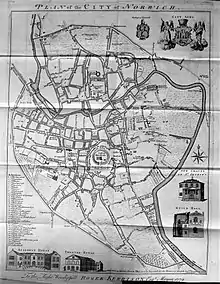
The Norwich Society of Artists was founded in 1803 by John Crome and Robert Ladbrooke as a club where artists could meet to exchange ideas. Its aims were "an enquiry into the rise, progress and present state of painting, architecture, and sculpture, with a view to point out the best methods of study to attain the greater perfection in these arts." The society's first meeting was in "The Hole in the Wall" tavern; two years later it moved to premises which allowed it to offer members work and exhibition space. Its first exhibition opened in 1805, and was such a success that it became an annual event until 1825. The building was demolished but the society re-opened three years later, in 1828, as "The Norfolk and Suffolk Institution for the Promotion of the Fine Arts" at a different venue and exhibitions continued until 1833.[1]
The leading light of the movement was John Crome who attracted many friends and pupils until his death in 1821. The mantle of leadership then fell on John Sell Cotman, a member of the society since 1807, who continued to keep the society together until he left Norwich for London in 1834. The society effectively ceased to exist from that date.
The Norwich School's great achievement was that a small group of self-taught working class artists were able to paint with vitality the hinterland surrounding Norwich, assisted by meagre local patronage. Far from creating pastiches of the Dutch 17th century, Crome and Cotman, along with Joseph Stannard, established a school of landscape painting which deserves greater fame; the broad washes of J.S. Cotman's water-colours anticipate French impressionism.[2]
One reason the Norwich School artists are not so well known as other painters of the period, notably Constable and Turner, is because the majority of their canvases were collected by the industrialist J. J. Colman (of Colman's mustard fame), and have been on permanent display in Norwich Castle Museum since the 1880s. This lack of wider exposure was remedied in 2001, when many of the school's major works were exhibited outside Norwich for the first time at the Tate Gallery, London in 2000.[3]
Gallery
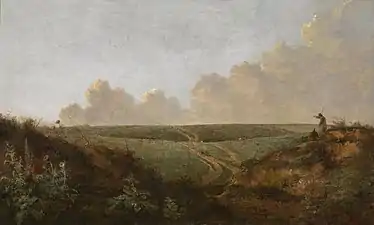 John Crome, Mousehold Heath, Norwich (c. 1818), Tate Britain
John Crome, Mousehold Heath, Norwich (c. 1818), Tate Britain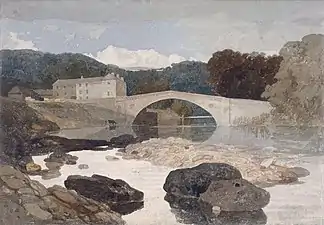
%252C_with_landscape_background_by_himself'.jpg.webp) Joseph Clover Portrait of George Vincent, background by Vincent (undated), Norfolk Museums Collections
Joseph Clover Portrait of George Vincent, background by Vincent (undated), Norfolk Museums Collections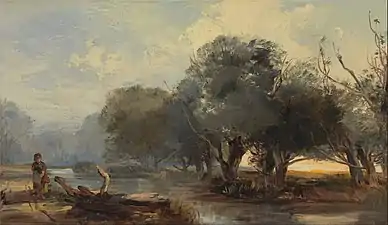 Henry Bright, On the Norfolk Broads (c. 1855), Yale Center for British Art
Henry Bright, On the Norfolk Broads (c. 1855), Yale Center for British Art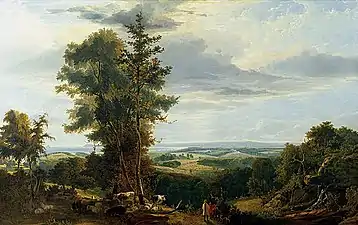 George Vincent, A distant view of Pevensey Bay, the landing place of King William the Conqueror (1820), Norfolk Museums Collections
George Vincent, A distant view of Pevensey Bay, the landing place of King William the Conqueror (1820), Norfolk Museums Collections Robert Ladbrooke, Beach Scene, Mundesley, Norfolk (undated), Norfolk Museums Collections
Robert Ladbrooke, Beach Scene, Mundesley, Norfolk (undated), Norfolk Museums Collections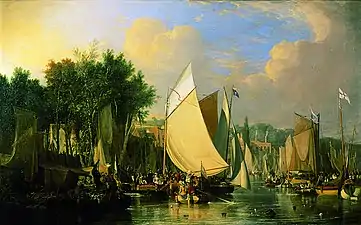 Joseph Stannard, Thorpe Water Frolic, Afternoon (undated), Norfolk Museums Collections
Joseph Stannard, Thorpe Water Frolic, Afternoon (undated), Norfolk Museums Collections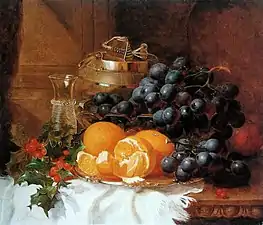 Eloise Harriet Stannard, Christmas still life (1886), Museum of John Paul II Collection, Warsaw
Eloise Harriet Stannard, Christmas still life (1886), Museum of John Paul II Collection, Warsaw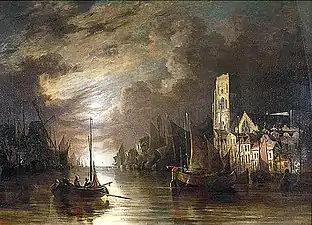 John Berney Crome, Amsterdam, The Netherlands (undated), Norfolk Museums Collections
John Berney Crome, Amsterdam, The Netherlands (undated), Norfolk Museums Collections Robert Ladbrooke, Fishermen on a Beach with Boats (undated), Norfolk Museums Collections
Robert Ladbrooke, Fishermen on a Beach with Boats (undated), Norfolk Museums Collections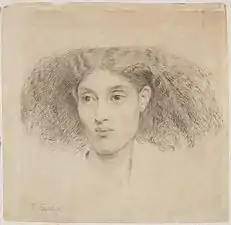 Frederick Sandys, Study of the head of a young mulatto woman full face (c. 1859), Art Gallery of New South Wales
Frederick Sandys, Study of the head of a young mulatto woman full face (c. 1859), Art Gallery of New South Wales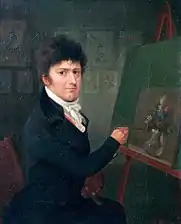 James Sillett, Self portrait 1803 (1803), Norfolk Museums Collections
James Sillett, Self portrait 1803 (1803), Norfolk Museums Collections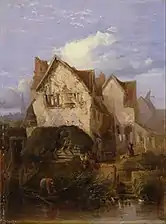 Thomas Lound, A View near Norwich (c. 1850), Yale Center for British Art
Thomas Lound, A View near Norwich (c. 1850), Yale Center for British Art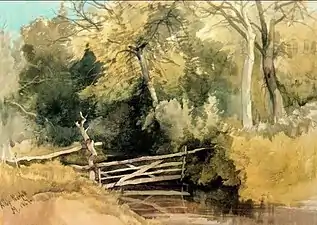 John Middleton, Alby (1847), Norfolk Museums Collections
John Middleton, Alby (1847), Norfolk Museums Collections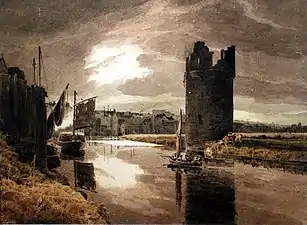 John Thirtle, Devil's Tower near King Street Gates – Evening (undated), Norfolk Museums Collections
John Thirtle, Devil's Tower near King Street Gates – Evening (undated), Norfolk Museums Collections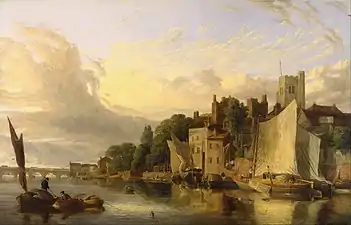 James Stark, Lambeth from the River looking towards Westminster Bridge (1818), Yale Center for British Art
James Stark, Lambeth from the River looking towards Westminster Bridge (1818), Yale Center for British Art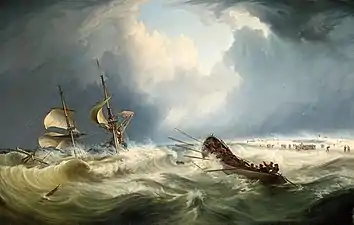 William Joy, The Rescue of the Survivors of the Brig Henry (undated)
William Joy, The Rescue of the Survivors of the Brig Henry (undated)
Members and associates
- Henry Bright
- James Bulwer
- Joseph Clover
- Samuel David Colkett and Victoria Susannah Colkett
- Edwin Cooper
- Daniel Coppin
- Frederick George Cotman
- John Joseph Cotman
- John Sell Cotman
- Miles Edmund Cotman
- John Crome ("Old Crome")
- John Berney Crome ("Young Crome")
- Edward Thomas Daniell
- Robert Dixon
- William Philip Barnes Freeman
- Joseph Geldart
- Charles Hodgson
- David Hodgson
- John Cantiloe Joy and William Joy
- Frederick Ladbrooke
- John Berney Ladbrooke
- Robert Ladbrooke
- Robert Leman
- Thomas Lound
- Horace Beevor Love
- Maria Margitson
- John Middleton
- Henry Ninham
- John Ninham
- Alfred Priest
- Anthony Sandys
- Frederick Sandys
- Obadiah Short
- James Sillett
- Alfred Stannard
- Alfred George Stannard
- Eloise Harriet Stannard
- Emily Stannard (Emily Coppin)
- Joseph Stannard
- Arthur James Stark
- James Stark
- John Thirtle
- George Vincent
References
- Holme, Geoffrey (Ed.). The Norwich School (The Studio Ltd., 1920). p. 1.
- Day, Harold. The Norwich School of Painters (Eastbourne Fine Art 1979)
- Brown, D. B. & Hemingway, Andrew & Lyles, Anne. Romantic Landscape, The Norwich School of Painters (Tate Gallery Publishing, 2000).
Further reading
- Brown, D. B.; Hemingway, Andrew; Lyles, Anne (2000). Romantic Landscape, The Norwich School of Painters. London: Tate Gallery Publishing.
- Clifford, Derek Plint (1965). Watercolours of the Norwich School. Cory, Adams & Mackay.
- Cundall, Herbert Minton; Holme, Charles Geoffrey (1920). The Norwich school; John ("Old") Crome, John Sell Cotman, George Vincent, James Stark, J. Berney Crome, John Thirtle, R. Ladbrooke, David Hodgson, M.E. [and] J.J. Cotman, etc. London: The Studio Ltd.
- Day, Harold (1979). The Norwich School of Painters. Eastbourne, UK: Eastbourne Fine Art. ISBN 978-0-902010-10-9.
- Dickes, William Frederick (1905). The Norwich school of painting: being a full account of the Norwich exhibitions, the lives of the painters, the lists of their respecitve exhibits and descriptions of the pictures. Norwich: Jarrold & Sons Ltd.
- Fawcett, Trevor (1974). The rise of English provincial art: artists, patrons, and institutions outside London, 1800-1830. London: Clarendon Press. ISBN 978-0-19-817328-1.
- Hemingway, Andrew (1979). The Norwich School of Painters, 1803-33. Oxford: Phaidon. ISBN 978-0-7148-2001-9.
- Moore, Andrew W. (1985). The Norwich School of Artists. HMSO/Norwich Museums Service.
- Mottram, R.H. (1931). John Crome of Norwich. London: John Lane The Bodley Head Limited.
- Rajnai, Miklos; Stevens, Mary (1976). The Norwich Society of Artists, 1805-1833: a dictionary of contributors and their work. Norfolk Museums Service for the Paul Mellon Centre for Studies in British Art.
- Scott, Peter Kennedy (1998). A Romantic Look at Norwich School Landscapes: By a Handful of Great Little Masters. ISBN 978-0-9534711-0-2.
- Searle, Geoffrey R. (2015). Etchings of the Norwich School. Norwich: Lasse Press. ISBN 978-0-9568758-9-1.
- Walpole, Josephine (1997). Art and Artists of the Norwich School. Woodbridge: Antique Collectors' Club. ISBN 978-1-85149-261-9.
External links
| Wikimedia Commons has media related to the Norwich School of painters. |
- The Norwich School (Andrew Graham Dixon, Sunday Telegraph features)
- Norfolk Museums service
